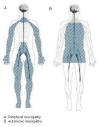Search Cidpusa web
Information on inflammatory autoimmune diseases
For a complete simple guide on treatment of Diabetic Amyotrophy
What is Diabetic Amyotrophy?
Diabetic amyotrophy is a condition which occurs in patients with diabetes (more likely in those with type II than type I). It usually starts with a severe pain at night then involves weakness a muscles of the thigh, hip, and buttocks. The symptoms usually occur on one side of the body but may involve both sides. Untreated the condition can last five months. Recent studies suggest a role for immunomodulating agents in certain types of diabetic neuropathy, including diabetic amyotrophy. This condition is very similar to CIDP or GBS but affects mainly the proximal muscles. See the diagnosis page link is on left top of this page.
Who gets Diabetic Amyotrophy?
Older men and middle aged women are more likely to acquire diabetic amyotrophy. Approximately 1% of those adults with diabetes will obtain this condition. Once it happens on one leg then it will affect the other.
How is Diabetic Amyotrophy Diagnosed?
This condition is diagnosed by history alone. There is elevated CRP and ESR.
How is Diabetic Amyotrophy Treated?
This condition frequently will improve with time and the body will heal itself. Physical therapy and strict observation of blood glucose levels are recommended to
help diabetic amyotrophy. Medications may help with the pain. However the cidpusa e-book lists the simple protocol which will make the patient fully mobile by day five. The medicine ciprofloxcillin is used and in four days full recovery is achieved. IVIg helps diabetic
amytrophy. Full protocol described in the e-book.Electronic stimulation is also effective treatment. Please see the electronic treatment
guide. The electronic devices used. click to enlarge
click to enlarge
Studies on diabetic polyneuropathy patients with IVIg
Pain Med. 2009 Nov;10(8):1476-80. Epub 2009 Sep 25.
Intravenous immunoglobulin for the treatment of diabetic lumbosacral radiculoplexus neuropathy. Tamburin S,
Zanette G.
Department of Neurological Sciences and Vision, Section of Rehabilitative Neurology, University of Verona, GB Rossi Hospital, Verona, Italy.
The
objective of this study was to evaluate the effect of intravenous immunoglobulin (IVIg) therapy in diabetic lumbosacral radiculoplexus neuropathy (DLRPN) patients
who did not respond to analgesic drug therapy and corticosteroids. Background. DLRPN is a rare painful condition that may occur in diabetes mellitus (DM). At the
moment, there are limited therapeutic options for DLRPN.
METHODS:
We recruited five patients affected by type 2 DM and DLRPN. They were selected from a cohort of
13 consecutive DLRPN patients. Inclusion criteria were severe pain (visual analog scale [VAS] > 4/10) and no response to pain symptomatic therapy and corticosteroids.Patients
were treated with IVIg (0.4 g/kg/day for 5 days). Outcome measures were VAS, time of onset and duration of pain relief, the Medical Research Council (MRC) scale for
lower limb muscle strength, and walking distance. (EMG) were retested after IVIg.
RESULTS:
Four of the patients had positive pain response after IVIg.
VAS reduction started 5-10 days after IVIg infusion. Two patients underwent additional IVIg infusions due to pain reappearance after 7-18 months, again with positive
response. VAS, MRC scale, and walking distance significantly improved at 1 month (Wilcoxon nonparametric test, two-tailed, P < 0.05). Electrodiagnostic testing was
unchanged, but needle EMG showed reduction of denervation signs after IVIg.
CONCLUSIONS:
IVIg may rapidly reduce pain and improve motor function in
DLRPN despite previous negative response to corticosteroids. IVIg may be repeated in those patients who experience disease relapse. Future double-blind trials are needed to
evaluate the role of IVIg in DLRPN
Pathalogy in CIDP and autoimmune diseasesWorld Wide Consultation by Internet
July-1 -2021